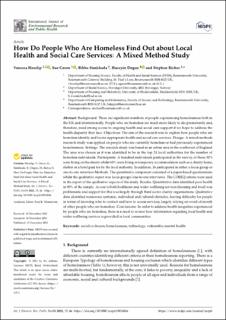| dc.contributor.author | Heaslip, Vanessa | |
| dc.contributor.author | Green, Sue | |
| dc.contributor.author | Simkhada, Bibha | |
| dc.contributor.author | Dogan, Huseyin | |
| dc.contributor.author | Richer, Stephen | |
| dc.date.accessioned | 2022-07-13T13:00:35Z | |
| dc.date.available | 2022-07-13T13:00:35Z | |
| dc.date.created | 2022-05-09T11:06:14Z | |
| dc.date.issued | 2021-12 | |
| dc.identifier.citation | Heaslip, V., Green, S., Simkhada, B., Dogan, H., & Richer, S. (2021). How Do People Who Are Homeless Find Out about Local Health and Social Care Services: A Mixed Method Study. International Journal of Environmental Research and Public Health, 19(1), 46. | en_US |
| dc.identifier.issn | 1661-7827 | |
| dc.identifier.uri | https://hdl.handle.net/11250/3005081 | |
| dc.description.abstract | Background: There are significant numbers of people experiencing homelessness both in the UK and internationally. People who are homeless are much more likely to die prematurely and, therefore, need strong access to ongoing health and social care support if we hope to address the health disparity they face. Objectives: The aim of the research was to explore how people who are homeless identify and locate appropriate health and social care services. Design: A mixed methods research study was applied on people who are currently homeless or had previously experienced homelessness. Settings: The research study was based in an urban area in the southwest of England. The area was chosen as it was identified to be in the top 24 local authorities for the number of homeless individuals. Participants: A hundred individuals participated in the survey, of those 32% were living on the streets whilst 68% were living in temporary accommodation such as a charity home, shelter or a hotel paid for by the local authority. In addition, 16 participated in either a focus group or one-to-one interview Methods: The quantitative component consisted of a paper-based questionnaire whilst the qualitative aspect was focus groups/one-to-one interviews. The COREQ criteria were used in the report of the qualitative aspects of the study. Results: Quantitative data identified poor health in 90% of the sample. Access to both healthcare and wider wellbeing services (housing and food) was problematic and support for this was largely through third sector charity organisations. Qualitative data identified numerous systemic, individual and cultural obstacles, leaving difficulty for people in terms of knowing who to contact and how to access services, largely relying on word of mouth of other people who are homeless. Conclusions: In order to address health inequities experienced by people who are homeless, there is a need to review how information regarding local health and wider wellbeing services is provided in local communities. | en_US |
| dc.language.iso | eng | en_US |
| dc.publisher | MDPI | en_US |
| dc.rights | Navngivelse 4.0 Internasjonal | * |
| dc.rights.uri | http://creativecommons.org/licenses/by/4.0/deed.no | * |
| dc.subject | hjemløshet | en_US |
| dc.subject | sosial ekskludering | en_US |
| dc.subject | mental helse | en_US |
| dc.subject | psykisk helse | en_US |
| dc.subject | teknologi | en_US |
| dc.title | How do people who are homeless find out about local health and social care services: A mixed method study | en_US |
| dc.type | Peer reviewed | en_US |
| dc.type | Journal article | en_US |
| dc.description.version | publishedVersion | en_US |
| dc.rights.holder | © 2021 by the authors | en_US |
| dc.subject.nsi | VDP::Samfunnsvitenskap: 200::Sosialt arbeid: 360 | en_US |
| dc.subject.nsi | VDP::Medisinske Fag: 700::Helsefag: 800 | en_US |
| dc.source.volume | 19 | en_US |
| dc.source.journal | International Journal of Environmental Research and Public Health (IJERPH) | en_US |
| dc.source.issue | 1 | en_US |
| dc.identifier.doi | 10.3390/ijerph19010046 | |
| dc.identifier.cristin | 2022589 | |
| dc.source.articlenumber | 46 | en_US |
| cristin.ispublished | true | |
| cristin.fulltext | original | |
| cristin.qualitycode | 1 | |

